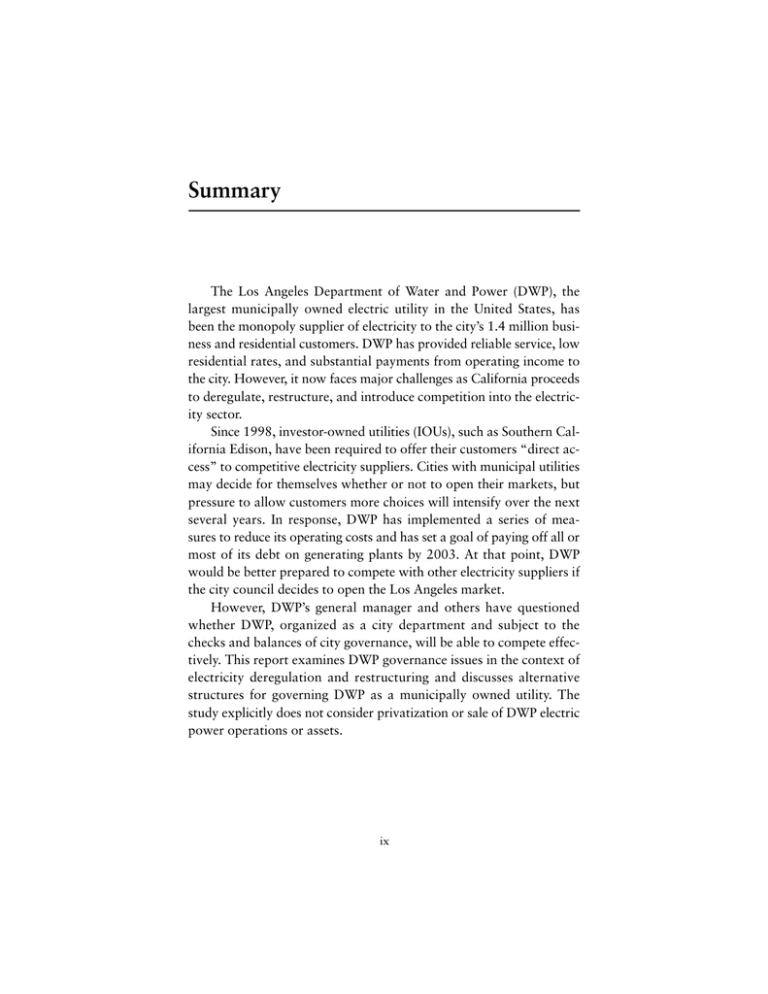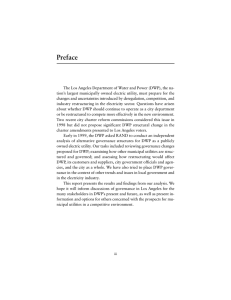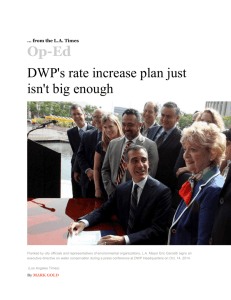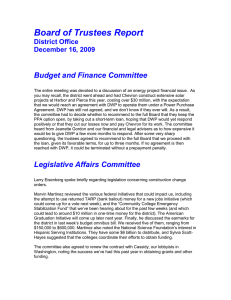Summary
advertisement

Summary The Los Angeles Department of Water and Power (DWP), the largest municipally owned electric utility in the United States, has been the monopoly supplier of electricity to the city’s 1.4 million business and residential customers. DWP has provided reliable service, low residential rates, and substantial payments from operating income to the city. However, it now faces major challenges as California proceeds to deregulate, restructure, and introduce competition into the electricity sector. Since 1998, investor-owned utilities (IOUs), such as Southern California Edison, have been required to offer their customers “direct access” to competitive electricity suppliers. Cities with municipal utilities may decide for themselves whether or not to open their markets, but pressure to allow customers more choices will intensify over the next several years. In response, DWP has implemented a series of measures to reduce its operating costs and has set a goal of paying off all or most of its debt on generating plants by 2003. At that point, DWP would be better prepared to compete with other electricity suppliers if the city council decides to open the Los Angeles market. However, DWP’s general manager and others have questioned whether DWP, organized as a city department and subject to the checks and balances of city governance, will be able to compete effectively. This report examines DWP governance issues in the context of electricity deregulation and restructuring and discusses alternative structures for governing DWP as a municipally owned utility. The study explicitly does not consider privatization or sale of DWP electric power operations or assets. ix x GOVERNANCE IN A CHANGING MARKET The Current DWP Governance Structure Governance of the DWP is shared among the Board of Water and Power Commissioners, the office of the mayor, the city council and its staff, and the city attorney. In effect, the DWP general manager must report to all these entities, which may themselves have conflicting objectives. Seventy-five years ago, the city charter established a strong commission with primary authority to oversee the department. But through charter amendments passed over the past two decades, the mayor and council have gained more control at the expense of the commission. The mayor has the power to appoint and remove Water and Power Commissioners. The council must confirm each appointment and removal by majority vote, but under new charter amendments that went into effect on July 1, 2000, the mayor may remove a commissioner without council approval. It has become customary for newly elected mayors to appoint their own commissioners and remove unwanted holdovers. While justified politically as the way for the city’s top elected official to establish control over the DWP and other city departments, this effectively has vitiated the commission as an independent, nonpolitical governing board. The mayor also holds tight rein over the commission through “advice” from his staff, and by requiring approval of commission agenda items by the city administrative officer under Executive Directive 39. As the city’s legislative body, the council has both oversight responsibility for DWP and direct authority under the charter to approve rates, set job classifications and compensation under the city’s civil service system, approve property sales, and approve contracts of more than $150,000 or of more than three years in duration. The council has traditionally set electricity rates to benefit residential customers—i.e., voters. Council ordinances further specify, in considerably more detail, procedures for hiring and other personnel actions, issuing debt, contracting, negotiating long-term customer contracts, and many other operational matters. But the most controversial of the council’s authorities over DWP comes from a charter amendment known as Proposition 5, or “Prop. 5,” which allows the council to reconsider essentially any decision made by the commission. The threat of Prop. 5 veto further SUMMARY xi undermines the commission’s ability to exercise independent judgment in overseeing the DWP and results in more bureaucratic paperwork and delays in decisionmaking. The elected city attorney serves as legal advisor to the commission and DWP. The city attorney’s office provides the department’s legal staff and is responsible for making personnel and work assignments. Lawyers working on DWP legal matters report to the city attorney rather than to the DWP general manager or the commission. Moreover, the city attorney must approve any use of outside counsel. Decisionmaking and Operational Problems Under the Current Structure Not surprisingly, this divided governance structure complicates and slows down commission and DWP decisionmaking, as well as the department’s ability to take timely action. Specific issues include • a multilayer—often conflicting—reporting structure for the general manager; • constraints and delays in hiring managers, professionals, and skilled workers; • constraints and delays in obtaining effective legal representation; • cumbersome procurement and contracting procedures; • constraints in negotiating customer contracts; and • politically driven DWP financing of other city operations. The current structure was put in place deliberately to provide extensive checks and balances for a government department that had a monopoly on providing essential water and power services. Delays in making or implementing business decisions were of less concern and have not had much adverse impact on DWP revenues or profitability during the monopoly era. But they can make the difference between winning and losing customers in a competitive market. DWP business customers who now subsidize residential rates are particularly apt to respond to lower cost or more flexible alternatives. A substantial loss of business customers would inevitably lead to reduced DWP operat- xii GOVERNANCE IN A CHANGING MARKET ing income and strong pressure on the mayor and council to cut either DWP payments to the city or raise residential electric rates, or both. Other Possible Governance Models for DWP Many municipal utilities in North America have different and generally more streamlined governance arrangements. Such models include the following: • Direct reporting to the city council (e.g., Austin, Texas; Colorado Springs, Colorado). • Independent city agency (e.g., Jacksonville, Florida; Knoxville, Tennessee). • City-owned corporation (e.g., Toronto, Ontario; Safford, Arizona). • Municipal Utility District (e.g., Sacramento, California). • Joint Powers Agency (e.g., Southern California Public Power Authority). Direct reporting to the city council works well in smaller cities but does not seem appropriate for a utility as large and complex as the DWP or for a city as diverse and fractious as Los Angeles. A Municipal Utility District or a Joint Powers Agency would offer flexibility and independence in conducting day-to-day operations; but each would require new state legislation as well as local restructuring and thus might be difficult to achieve politically. If passed by county voters, however, a Municipal Utility District would be more difficult to undo than the other options. For DWP, operating as a city-owned corporation or as a more independent city agency appear promising alternatives to the status quo. Either one would help the utility become more efficient, businesslike, and responsive to changing market conditions. However, both involve substantial restructuring and new charter amendments to invest primary governance responsibility in a single board. With corporatization, an expanded and independent board of directors would govern the utility. In the city agency option, a similarly expanded and more independent commission would serve as the governing board. Restructuring SUMMARY xiii would give the new board considerably more authority to oversee the utility and would deliberately distance the board and utility from oversight by the mayor and council on normal business matters. A third, but probably less effective, option is to modify the existing governance structure to improve DWP decisionmaking and operations. The goal would be to focus governance on policy issues, limit involvement in routine operations, and streamline approval processes. Proposed changes in this option would include • authorizing water and power commissioners to serve full fiveyear terms; • enabling the commission and DWP to hire its own legal advisor and staff; • eliminating formal executive review of commission agenda items; and • eliminating council oversight of DWP routine business and giving DWP more flexibility in procurement, contracting, and personnel matters. The first two changes would require new charter amendments, but the mayor and council could implement the latter two within the existing structure. All three options would maintain the primary public benefits of a municipal utility: local ownership and local rate setting authority; tax exempt financing and preferences in purchasing federal power; exemption from most income, property, and business taxes; sensitivity to economic development, environmental concerns, and other social goals; and commitment to make direct transfers to the city’s general fund. Each option also keeps the utility’s governing board accountable to elected city officials. Deregulation and Future Governance for DWP: Findings and Recommendations Electricity deregulation has recently come under fire as higher demand for power in California brought blackouts in the Bay Area, xiv GOVERNANCE IN A CHANGING MARKET sharp spikes in the wholesale price of electricity, and a doubling of retail prices for customers of San Diego Gas & Electric, the first investorowned utility to be fully deregulated. Retail prices for customers of other IOUs also may rise as the transitional rate ceilings under the state deregulation plan phase out by the end of 2001. As a consequence, customers and government officials fought successfully this summer to cap wholesale spot prices, and some are demanding that deregulation be rescinded or at least substantially revised. Throughout the crisis, DWP not only kept rates stable and continued to reduce debt, but it has earned substantial profits by selling electricity it generates to the California Independent System Operator (ISO). Whereas the IOUs sold off their generating facilities under the state deregulation plan, DWP still maintains substantial reserves. A recent opinion piece in the Los Angeles Times called DWP “The Unexpected Hero in a Deregulated Electricity Market” and recommended that the city “say ‘no’ to deregulation.” Is it necessary or desirable to deregulate electricity prices and permit direct access competition in Los Angeles? In the short run, the answer is clearly no. But in the longer run, if and when the wild price fluctuations observed this summer settle down and orderly electricity markets again become the norm, the question will arise again. We believe this is likely to occur in the 2002–2004 time frame as new generation capacity comes into service in California, and the IOUs and the California ISO gain more experience in stabilizing electricity markets. While city, state, and federal governments stand ready to act to protect consumers from large, short-term price increases, we do not expect them to reverse the underlying trend toward encouraging more competition among electricity suppliers. Whether or not the Los Angeles electricity market is opened to competition, DWP’s governance needs simplification and streamlining. We believe that the restructuring options of corporatization or governance by a strong commission deserve serious attention. Under its current governance structure—even with the modifications recommended in the third option described above—DWP would find itself severely constrained in meeting the competition from more agile private SUMMARY xv firms that we expect to emerge around 2002–2003. In principle, a cityowned corporation could have more operational flexibility than an independent city agency, but either form would support faster decisionmaking and greater responsiveness than does the present structure. Establishing a single governing board, with clear authority and considerable independence from day-to-day political influences, seems a prerequisite for success in a more competitive marketplace. The issues of DWP governance and possible restructuring are necessarily linked to the council’s consideration of whether or when to open the Los Angeles electricity market. Even if the council’s decision on direct access is not made until 2002 or later, discussion and debate should begin soon. The public needs to become aware of issues that, while often technical and complex, will directly affect them as taxpayers and ratepayers. The effects of competition on DWP, its employees, its customers, and the city as a whole need to be more fully explored. Possible charter amendments need to be vetted by the council before they can be put before the voters. These issues also are likely to arise in city council races and in the mayoral election of 2001. Whatever the council’s decision on direct access competition, DWP must improve its decisionmaking pace and processes. It must run faster in the future to stay competitive. Strengthening its governance structure seems essential to ensuring reliable electricity supplies, low rates, and adequate payments to the city, as well as to maintaining Los Angeles’s leadership among the nation’s municipal utilities.






![MA1S12 (Timoney) Tutorial sheet 8a [March 19–24, 2014] Name: Solution](http://s2.studylib.net/store/data/011008032_1-b2fb2d48f663eaa5a5f0eab978a3a136-300x300.png)
